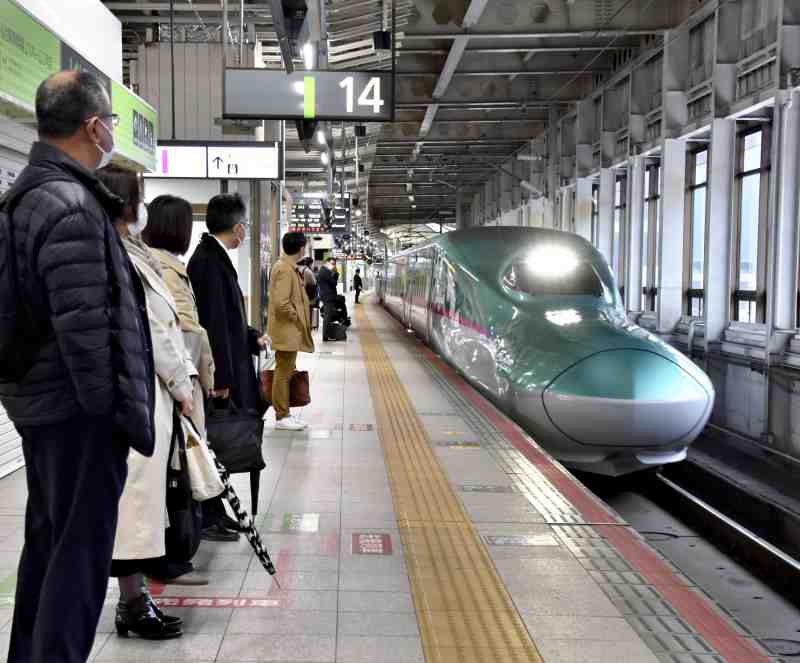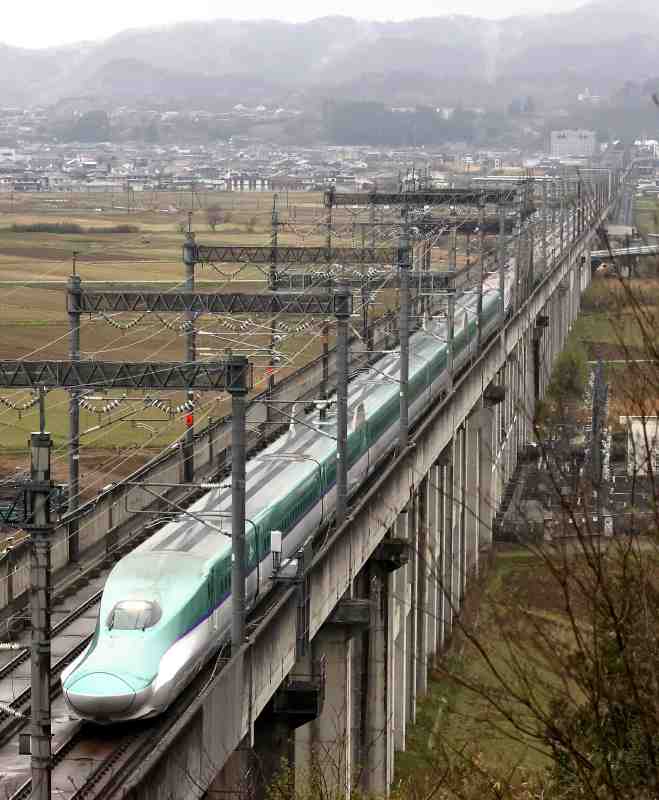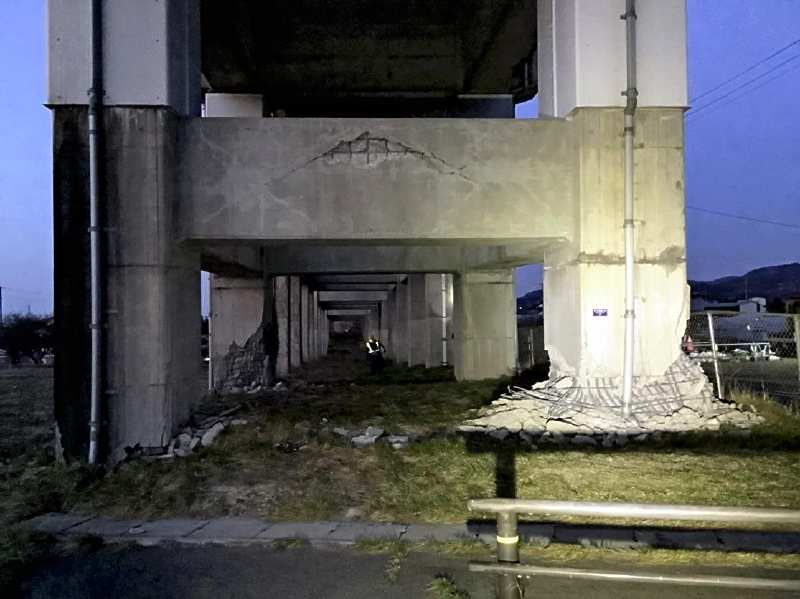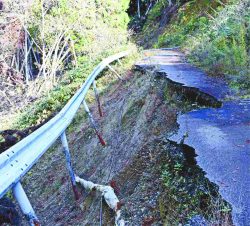Extensive damage to Japan’s Tohoku Shinkansen line raises questions about quake resistance

Passengers wait for a Tohoku Shinkansen train bound for Tokyo to arrive at JR Sendai Station’s platform on Thursday.
7:00 JST, April 16, 2022
Passengers arriving on the Tohoku Shinkansen platform at Tokyo and Fukushima stations Thursday — the day operations resumed along the full length of the line, almost one month after a powerful earthquake — were greeted by station attendants holding banners. A 60-year-old company employee, traveling from Fukushima Station to Sendai for work, was delighted as he boarded the train.
“The regular train lines have been very crowded, and commuting took much longer,” said the man from Fukushima City. “I’ve realized just how inconvenient life is without this Shinkansen.”
Tourist areas along the line also lauded the restored service. “Our sales have never been so bad, because of the double whammy of the coronavirus pandemic and then the earthquake,” said a 79-year-old woman who runs a souvenir shop in the Tsuchiyu hot spring resort in Fukushima City. “I’m glad the full line resumed operations before the upcoming Golden Week holidays.”
While the recommencement of services was a welcome step, there are lingering concerns a similar disruption could occur if another powerful quake hits the region.
The March 16 earthquake off the coast of Fukushima Prefecture, measuring upper 6 on the Japanese seismic intensity scale of 7, caused the Shinkansen line section between Nasu-Shiobara, Tochigi Prefecture, and Morioka to be suspended. Services resumed section by section as repair work was completed, and operations restarted along the entire line Thursday as the section between Fukushima and Sendai stations came back into service. Severe damage to viaduct pillars that had yet to be fully reinforced against earthquakes resulted in the length of time required to fully restart services — 29 days — being second only to the 49 days taken to restore operations after the March 2011 Great East Japan Earthquake.
For the time being, JR East will continue running trains at a reduced speed of about 160 kph on the section between Koriyama, Fukushima Prefecture, and Ichinoseki, Iwate Prefecture. The trains will resume operating at a top speed of 320 kph when the schedule returns to normal after the Golden Week holidays, because the rails still need fine adjustments and some temporarily repaired overhead wires must be re-tensioned.
The number of Shinkansen trains in service on the line will be reduced by 10% to 20% until those repairs are completed. Consequently, traveling between Tokyo and Sendai will take about 30 minutes longer than usual, and between Tokyo and Morioka about one hour longer.
Quake-twisted rebar

A Tohoku Shinkansen train is seen running near the site of a derailment in Shiroishi, Miyagi Prefecture, on Thursday morning.
Services on the Tohoku Shinkansen line also were suspended when an earthquake measuring upper 6 struck off the Fukushima coast in February 2021. Getting all services fully up and running after that quake took 11 days. This time it took significantly longer because two pillars of the viaducts in the section between Fukushima and Sendai were severely damaged.
Some of the concrete encasing these pillars broke off, and the rebar inside them was bent out of shape. Bridge beams dropped by several tens of centimeters, and the rails were warped. Repairing these sections required jacking up the base of the pillars and replacing the rebar inside them.
JR East insisted the damage was “not fatal” to these pillars. However, Nihon University Prof. Hitoshi Tsunashima, an expert in railroad engineering, said: “Any subsidence or warping of the rails could affect the safety of train operations. JR East must quickly conduct additional strengthening work to prepare for the next big earthquake.”
Quake-resistance rate low

This pillar of the Tohoku Shinkansen line was severely damaged in the powerful March 16 earthquake.
Since the 1995 Great Hanshin Earthquake destroyed a viaduct of the Sanyo Shinkansen line, the Land, Infrastructure, Transport and Tourism Ministry has pressed each JR rail operator to bolster the quake-resistance of Shinkansen lines constructed before the disaster.
JR East determined that 55,000 of the 77,000 pillars supporting viaducts on the Tohoku and Joestu Shinkansen lines required increased resistance to earthquakes. These pillars were sorted into three categories, depending on their level of risk — 19,000 were considered in danger of collapse; 18,000 had relatively low seismic resistance; and 18,000 had relatively high seismic resistance. JR East has gradually been conducting these repairs.
Work to strengthen pillars in the first two categories has mostly been completed. JR East says quake-resistance improvements have been finished in pillars “that required it.” However, work has barely started on pillars in the third category. The pillars that were severely damaged in last month’s earthquake fell under this category.
Furthermore, just 67% of all the 55,000 pillars that required strengthening have undergone quake-resistance work. The delay in reinforcing these pillars is striking when considering that almost 100% of pillars on the Tokaido Shinkansen line and 98% on the Sanyo Shinkansen line have been made quake-resistant.
Following last month’s earthquake, Land, Infrastructure, Transport and Tourism Minister Tetsuo Saito said he wanted the quake-resistance standards and strengthening plans for civil engineering structures, including piers, to be reviewed. The ministry plans to hold discussions with JR East to examine issues such as the order of priority given to previous quake-resistance work.
"Society" POPULAR ARTICLE
-

M4.9 Earthquake Hits Tokyo, Neighboring Prefectures
-

Israeli Tourists Refused Accommodation at Hotel in Japan’s Nagano Pref., Prompting Protest by Israeli Embassy and Probe by Prefecture
-

M7.5 Earthquake Hits Northern Japan; Tsunami Waves Observed in Hokkaido, Aomori and Iwate Prefectures
-

Tsukiji Market Urges Tourists to Avoid Visiting in Year-End
-

M5.7 Earthquake Hits Japan’s Kumamoto Pref., Measuring Upper 5 Intensity, No Tsunami Expected
JN ACCESS RANKING
-

Keidanren Chairman Yoshinobu Tsutsui Visits Kashiwazaki-Kariwa Nuclear Power Plant; Inspects New Emergency Safety System
-

Tokyo Economic Security Forum to Hold Inaugural Meeting Amid Tense Global Environment
-

Imports of Rare Earths from China Facing Delays, May Be Caused by Deterioration of Japan-China Relations
-

University of Tokyo Professor Discusses Japanese Economic Security in Interview Ahead of Forum
-

Japan Pulls out of Vietnam Nuclear Project, Complicating Hanoi’s Power Plans
























